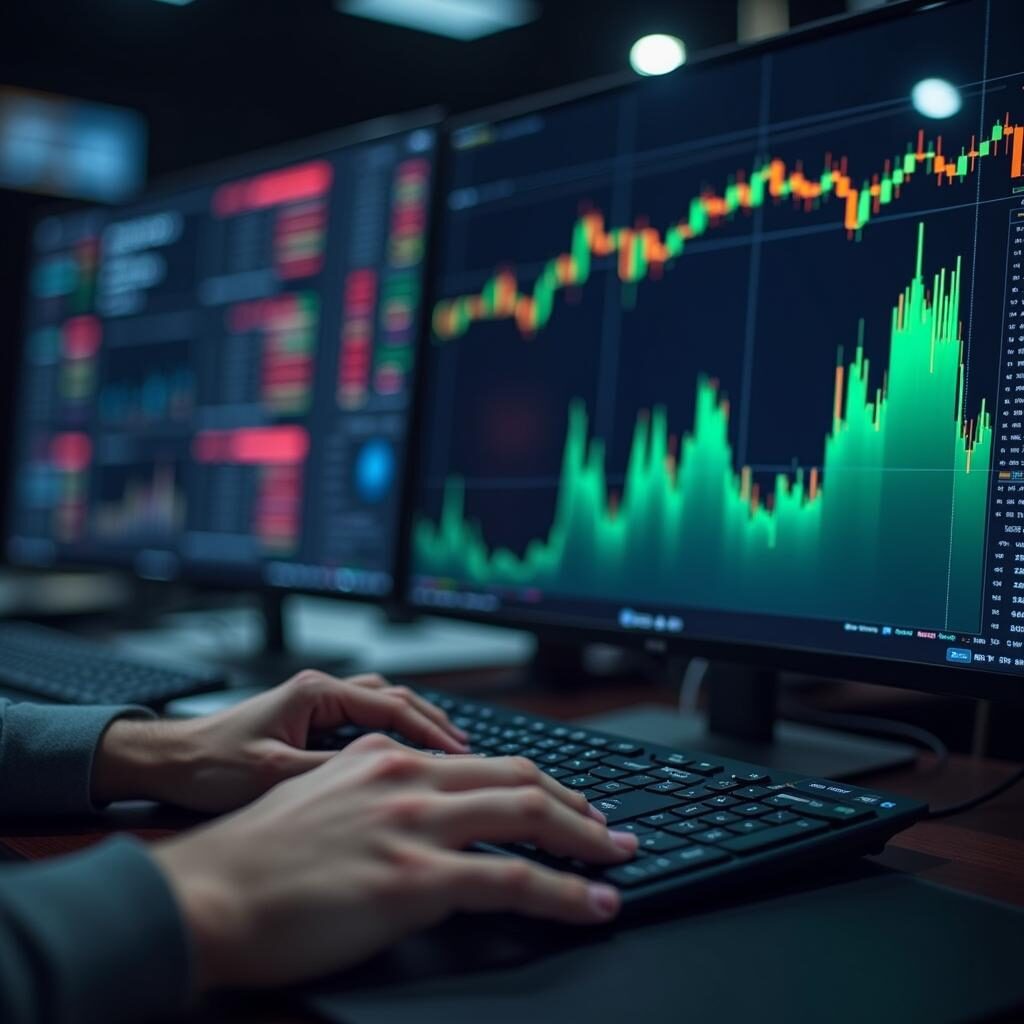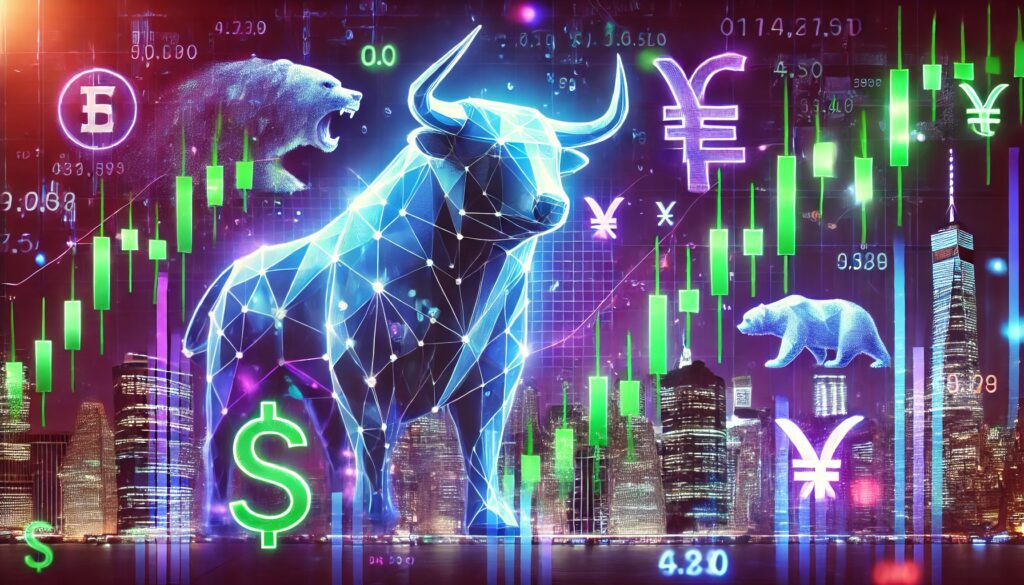
AI is reshaping financial markets like never before. From hedge funds to individual traders, AI’s ability to process data and predict trends is revolutionizing stock trading. But does this new edge truly level the playing field, or does it tilt it further?
AI in High-Frequency Trading: A Market Gamechanger
What is High-Frequency Trading (HFT)?
High-frequency trading (HFT) relies on algorithms to execute trades in milliseconds. It uses AI to identify market inefficiencies faster than any human could.
HFT firms leverage real-time market data to exploit tiny price discrepancies. AI-powered HFT systems constantly adapt, learning from market conditions to optimize trading strategies.
This speed gives firms with advanced AI tools an undeniable advantage, leaving traditional traders struggling to keep up.
Hedge Funds: Leading the Charge with AI
Hedge funds have embraced AI for HFT, using it to detect patterns and make split-second decisions. Tools like machine learning algorithms analyze vast amounts of market data, from news sentiment to historical prices.
Big players like Renaissance Technologies and Citadel use proprietary AI systems to execute trades with uncanny precision. Access to such technology requires hefty investments, widening the gap between retail traders and institutional giants.
Risks of AI in High-Frequency Trading
While lucrative, HFT has its risks. Flash crashes—market events caused by algorithmic trading gone awry—can destabilize markets. In 2010, the Dow Jones plunged nearly 1,000 points within minutes, partly due to faulty algorithms.

Predictive Modeling: The Power of Forecasting
How AI Predicts Market Trends
AI’s predictive capabilities stem from machine learning models trained on historical data. These models identify patterns, making predictions about stock prices or volatility.
For instance, natural language processing (NLP) helps traders analyze market sentiment from news or social media. AI can even incorporate macroeconomic indicators, giving a 360-degree view of potential market movements.
Individual Traders: Access to Predictive AI
For individual traders, predictive tools are more accessible than ever. Platforms like TradingView and Alpaca offer AI-powered analytics, enabling smarter investment decisions.
However, these tools lack the sophistication of hedge fund-grade systems, which still dominate the market. Even with access to basic AI, retail traders often find themselves at a disadvantage.
Ethical Concerns in Predictive Modeling
AI-driven predictions raise ethical questions. Does access to better forecasting tools create an unfair market environment? Critics argue that it disproportionately benefits the wealthy, further concentrating financial power.
Leveling the Playing Field: Is it Possible?
Democratizing AI Tools for Traders
Some argue that affordable AI tools are narrowing the gap. Retail investors now have access to data and insights once reserved for institutional players. AI democratization is happening, but it’s slow and uneven.
The Role of Regulation in AI Trading
Governments are grappling with how to regulate AI in stock trading. Rules like the EU’s AI Act aim to promote fairness and transparency.
However, enforcing regulations on AI systems—especially in highly automated markets—is complex. Policymakers must strike a balance between innovation and market integrity.
Collaboration vs. Competition
Some hedge funds and startups are bridging the gap by offering their AI tools to retail investors. Partnerships and educational initiatives may ultimately foster a more equitable trading environment.
The Divide: AI’s Impact on Institutional and Retail Trading
Institutional Players: A Deep Dive into AI Dominance
Hedge funds and institutional traders hold the lion’s share of AI capabilities. They invest millions in custom AI systems designed for unparalleled precision.
For instance, hedge funds use quantitative trading models to automate complex strategies. These models combine vast datasets—such as stock fundamentals, economic indicators, and sentiment analysis. The result? A near-unbeatable edge in predicting market trends.
Moreover, AI-driven systems minimize human error, allowing institutions to capitalize on fleeting opportunities. This exclusivity, however, keeps smaller players at a disadvantage.
Retail Traders: Limited, but Growing Access to AI
The rise of fintech platforms has allowed individual traders to leverage basic AI tools. Apps like Robinhood and eToro integrate AI to suggest trades or analyze patterns.
Yet, the gap remains. Retail tools often simplify advanced techniques, meaning individual traders rely on pre-packaged algorithms rather than fine-tuning their strategies.
The discrepancy in computational power and real-time data access ensures institutions maintain dominance in AI-driven trading.
Implications for Market Dynamics
This disparity raises questions about market efficiency and fairness. Is it fair for institutions to wield AI in ways that systematically outperform smaller investors? Some argue that the sheer scale of institutional AI threatens to overshadow retail trading entirely.
Trading is about probabilities, and AI calculates them faster than ever.
— Financial Analyst
The Dark Side: Manipulation and Bias in AI Trading
Algorithmic Manipulation: A Hidden Threat
AI systems are not immune to exploitation. Rogue traders may program algorithms to manipulate prices, triggering artificial spikes or crashes.
This phenomenon, called quote stuffing, overwhelms the market with bogus orders. It creates an illusion of demand, leaving unsuspecting traders at a loss.
Bias in AI Systems
AI models are only as good as the data they’re fed. Bias in datasets—such as over-representing certain industries or geographies—can lead to skewed predictions.
Additionally, feedback loops occur when AI models reinforce existing market patterns. For example, if many systems predict a stock’s rise, their collective actions might artificially inflate its price.
Regulatory Challenges
Addressing manipulation and bias in AI trading demands sophisticated oversight. Regulators need AI tools themselves to monitor these highly automated systems. But keeping pace with technological advances remains a monumental challenge.
Innovations in AI Trading: The Future Landscape
Real-Time AI: From Reaction to Anticipation
The future of AI trading lies in real-time analytics. Edge computing allows AI to analyze market shifts as they occur, offering near-instant reactions.
Companies are also experimenting with reinforcement learning, where algorithms refine strategies based on simulated trading environments. This self-learning process ensures that AI adapts faster than human traders.
Decentralized Finance and AI Integration
Decentralized finance (DeFi) is reshaping how we trade assets. AI-powered bots now facilitate trading on blockchain-based exchanges, providing liquidity and executing transactions automatically.
This integration of AI and DeFi could create new opportunities for retail investors, leveling the playing field in emerging markets.
Quantum Computing: The Next Frontier
Quantum computing could revolutionize AI trading. Unlike traditional computers, quantum systems process data exponentially faster. This means AI models will gain even more precision in predicting market behaviors, widening the technological divide.
Institutional AI: Dominance Through Innovation
Renaissance Technologies: The Pinnacle of AI-Driven Trading
Often referred to as the most successful hedge fund in history, Renaissance Technologies has been a leader in leveraging AI for trading. Their flagship fund, the Medallion Fund, employs machine learning algorithms to uncover complex patterns in massive datasets.
With annual returns exceeding 60% before fees, Renaissance is a prime example of how cutting-edge AI can dominate markets. Its secrecy and exclusivity—only employees can invest in Medallion—underscore the competitive advantage proprietary AI provides.
JPMorgan Chase’s LOXM Algorithm
In 2017, JPMorgan Chase introduced LOXM, an AI-powered trading bot designed to execute trades efficiently while minimizing market impact. LOXM learns from billions of past trades, tailoring its approach for optimal execution.
The success of LOXM demonstrates how banks and institutions are using AI not just for speed, but for strategic finesse—executing large trades without tipping off competitors or destabilizing the market.
AI’s Role in Flash Crashes: Risks Amplified by Speed
The 2010 Flash Crash: When Algorithms Backfired
One of the most infamous examples of AI-related trading risks occurred on May 6, 2010. The Dow Jones Industrial Average plummeted nearly 1,000 points in minutes, erasing $1 trillion in market value before quickly recovering.
Investigations revealed that high-frequency trading algorithms exacerbated the crash by executing massive sell orders in response to rapid price drops, creating a feedback loop.
While the crash highlighted AI’s potential for market destabilization, it also prompted regulators to adopt measures like circuit breakers to prevent similar incidents.
Retail AI Tools: Leveling the Playing Field—To a Degree
Robinhood’s AI-Powered Investment Insights
Retail platforms like Robinhood now incorporate AI to analyze user portfolios and suggest investment opportunities. Tools like these empower novice traders to make data-driven decisions, but they pale in comparison to the capabilities of hedge fund-grade systems.
For instance, Robinhood Snacks, a content feature, uses AI to curate market news summaries tailored to users’ interests. This personalization helps traders stay informed but doesn’t offer the predictive modeling power that institutional tools provide.
AI Democratization: Fintechs and Startups Making Waves
Numerai: Crowdsourced AI Hedge Fund
Numerai, a hedge fund with a twist, uses crowdsourced AI models to predict stock market movements. Data scientists from around the world contribute algorithms, which Numerai combines into a “meta-model” to inform its trading strategies.
This approach has democratized AI participation, rewarding contributors for their models’ accuracy. While Numerai is innovative, it also illustrates the complexity of competing in a space dominated by proprietary institutional systems.
Alpaca: API-Driven Trading for Retail Investors
Alpaca offers an API platform that lets retail traders build their own AI-powered trading bots. By providing access to advanced tools and historical market data, Alpaca reduces the technological gap.
Still, these tools require coding knowledge, meaning they’re accessible only to technically savvy individuals.
Quantum Computing: Hedge Funds Eye the Next Frontier
D-Wave and Goldman Sachs: Quantum Meets AI
Quantum computing is set to redefine AI’s role in trading. Goldman Sachs has partnered with D-Wave, a leader in quantum computing, to explore how quantum algorithms can optimize portfolio management and trading strategies.
By solving complex problems exponentially faster than traditional computers, quantum AI could enable hedge funds to analyze more data, model scenarios with greater accuracy, and uncover hidden market inefficiencies.
Emerging Markets: AI Creates New Opportunities
Retail AI Tools in Developing Economies
Platforms like Zerodha in India and Freetrade in the UK are expanding AI’s reach to emerging markets. By lowering transaction costs and offering simple predictive tools, these platforms allow more individuals to participate in equity markets.
For example, Zerodha’s Varsity program integrates AI-powered learning tools to educate users on trading strategies, fostering financial literacy alongside access to markets.
Will AI Ever Truly Level the Playing Field?
The Promise of Open-Source AI
One potential equalizer is open-source AI. Platforms like TensorFlow and PyTorch empower individual traders and smaller firms to create custom trading models.
Open-source tools can lower the barrier to entry for advanced AI systems. However, building effective models still requires significant expertise and computational resources—areas where hedge funds excel.
Bridging the Knowledge Gap
Educational initiatives are vital for democratizing AI in trading. Programs offering courses in AI-driven finance can help retail investors and smaller firms understand and utilize these tools.
Collaborations between fintech platforms and AI researchers may also improve accessibility, enabling individuals to implement tailored algorithms without needing advanced technical skills.
A Dual-Edged Sword for Retail Investors
Despite its promise, AI may never fully level the playing field. Retail traders using AI tools risk over-reliance on pre-built models, which lack the adaptability of institutional-grade systems.
Meanwhile, hedge funds continue to pour resources into developing proprietary algorithms, staying ahead of the curve.
Key Takeaway: A Two-Speed Market?
While AI democratization is happening, the resource disparity between hedge funds and retail traders has created a two-speed market. Hedge funds race ahead with proprietary models and quantum computing, while retail traders rely on simplified tools.
This divide raises critical questions about the long-term implications of AI in trading:
- Will affordable AI tools ever match the sophistication of institutional-grade systems?
- How can regulators ensure fairness without stifling innovation?
AI may not yet have fully leveled the playing field, but its potential to disrupt and redefine trading remains unparalleled.
Resources
Research Papers & Articles
- “The Role of Artificial Intelligence in Financial Markets”
- Published in the Journal of Financial Economics, this paper explores AI’s predictive power and its influence on market dynamics.
- “High-Frequency Trading and Its Impact on Market Volatility”
- An academic analysis of how HFT affects price stability, available via SSRN.
SSRN Repository
- An academic analysis of how HFT affects price stability, available via SSRN.
- “Ethics of AI in Financial Trading” by Harvard Business Review
- Discusses the ethical dilemmas and responsibilities of using AI in finance.
Read on HBR
- Discusses the ethical dilemmas and responsibilities of using AI in finance.
Online Platforms and Tools
- Kaggle
- A platform where data scientists compete to develop trading algorithms. It’s a great way to test AI models using real-world financial data.
Kaggle Finance Challenges
- A platform where data scientists compete to develop trading algorithms. It’s a great way to test AI models using real-world financial data.
- Quandl
- A source for financial, economic, and alternative datasets. Useful for building machine learning models.
Visit Quandl
- A source for financial, economic, and alternative datasets. Useful for building machine learning models.
- Alpaca Markets
- Offers APIs for building and testing AI-driven trading bots for stocks and cryptocurrencies.
Explore Alpaca
- Offers APIs for building and testing AI-driven trading bots for stocks and cryptocurrencies.
Educational Resources
- Coursera: Machine Learning for Trading Specialization
- Taught by the University of Illinois, this course provides a foundation in AI and trading algorithms.
Coursera Link
- Taught by the University of Illinois, this course provides a foundation in AI and trading algorithms.
- AI in Finance by Udemy
- A practical course on applying AI tools in financial analysis and trading.
Udemy Course
- A practical course on applying AI tools in financial analysis and trading.
- Numerai Tournament
- A platform where data scientists can contribute trading models to a crowdsourced hedge fund and learn about real-world applications.
Numerai Tournament
- A platform where data scientists can contribute trading models to a crowdsourced hedge fund and learn about real-world applications.
Web Resources and Blogs
- QuantInsti Blog
- Regularly updated insights into algorithmic trading, AI applications, and industry trends.
Visit QuantInsti
- Regularly updated insights into algorithmic trading, AI applications, and industry trends.
- Two Sigma Blog
- Offers technical insights and research publications from one of the leading quantitative investment firms.
Explore Two Sigma Blog
- Offers technical insights and research publications from one of the leading quantitative investment firms.
- Towards Data Science
- Features articles on AI applications in finance, written by data science professionals.
Read Here
- Features articles on AI applications in finance, written by data science professionals.





